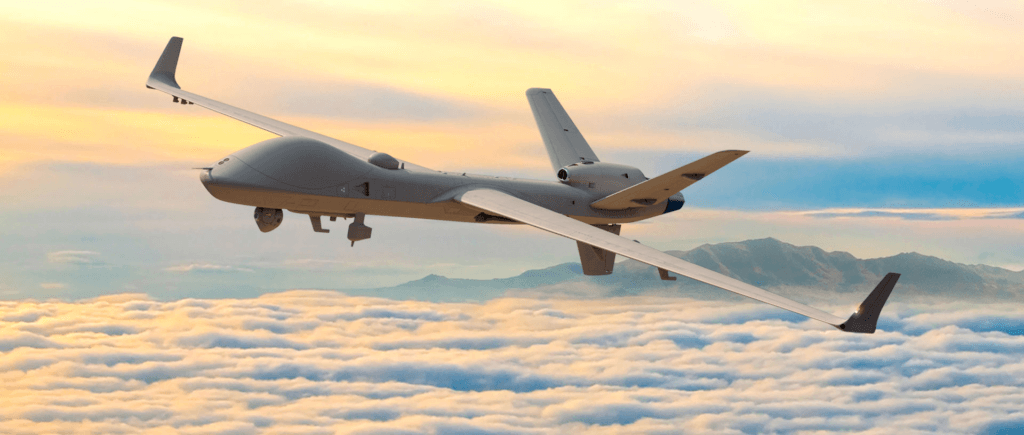Daily Current Affairs : 19-October-2023
In a significant development for India’s defense capabilities, a deal involving 31 MQ-9B Unmanned Aerial Vehicles (UAVs) from the United States is in progress, set to be finalized by February 2024. The deliveries of these advanced armed UAVs are slated to commence from February 2027, marking a pivotal moment in India’s military modernization efforts.

Acquisition Plan and Configuration
This deal includes 15 SeaGuardians tailored for the Indian Navy and 16 SkyGuardians, with eight each allocated for the Indian Army and Air Force. The MQ-9B, designed by General Atomics, falls under the category of High Altitude Long Endurance (HALE) Unmanned Aerial Vehicles. Noteworthy features include its ability to fly over the horizon via satellite for up to 40 hours, making it an invaluable asset for diverse military operations.
Versatile Applications
The SeaGuardian variant comes equipped with advanced capabilities such as a 360-degree surface-search maritime radar, automatic identification system, sonobuoy monitoring system, and sonobuoy dispensers. These attributes empower the SeaGuardian for persistent anti-surface and anti-submarine warfare missions, enhancing the Indian Navy’s maritime surveillance capabilities significantly.
Cost-Effectiveness and Integration
One of the most compelling aspects of the MQ-9B is its cost-effectiveness. General Atomics estimates that these UAVs can offer approximately 80% of the capability of large human-flown maritime patrol aircraft at just 20% of its cost per hour. Moreover, the MQ-9B seamlessly integrates with other U.S.-origin platforms already in operation by India, including the P-8Is, AH-64 Apache attack helicopters, and MH-60R multi-role helicopters. This integration expands the MQ-9B’s multi-domain mission set, enabling collaborative and efficient military operations.
Boosting Intelligence, Surveillance, and Reconnaissance (ISR) Capabilities
By providing round-the-clock surveillance capabilities extending far beyond India’s borders, the MQ-9Bs are poised to significantly enhance the Intelligence, Surveillance, and Reconnaissance (ISR) capabilities of the Indian armed forces. This augmentation in ISR capabilities is pivotal for maintaining national security, ensuring timely responses to potential threats, and bolstering India’s position on the global defense landscape.
Important Points:
- Acquisition Deal:
- India is in the process of acquiring 31 MQ-9B Unmanned Aerial Vehicles (UAVs) from the U.S.
- Deal expected to be concluded by February 2024, with deliveries starting from February 2027.
- Configuration:
- 15 SeaGuardians for the Indian Navy.
- 16 SkyGuardians, eight each for the Indian Army and Air Force.
- MQ-9B falls under the category of High Altitude Long Endurance (HALE) UAVs.
- MQ-9B Features:
- Capable of flying over the horizon via satellite for up to 40 hours.
- Designed for all-weather operations and integration into civil airspace.
- SeaGuardian variant equipped with advanced maritime surveillance technologies.
- Cost-Effectiveness and Integration:
- Provides 80% of the capability of large human-flown maritime patrol aircraft at 20% of its cost per hour.
- Seamless integration with existing U.S.-origin platforms in India, including P-8Is, AH-64 Apache attack helicopters, and MH-60R multi-role helicopters.
- Applications:
- Enhances maritime surveillance capabilities of the Indian Navy, with features like a 360-degree surface-search maritime radar and anti-submarine warfare systems.
- Provides round-the-clock surveillance capabilities for the Indian Army and Air Force, extending far beyond national borders.
- Significantly boosts Intelligence, Surveillance, and Reconnaissance (ISR) capabilities of the Indian armed forces.
- Strategic Significance:
- Represents a crucial step in India’s military modernization efforts.
- Strengthens India’s defense capabilities, making significant contributions to national security and global defense efforts.
Why In News
The 31 MQ-9B Unmanned Aerial Vehicles (UAVs) deal with the U.S. is expected to be concluded by February 2024, paving the way for advanced reconnaissance capabilities in military operations. Deliveries will commence from February 2027, bolstering national security and strengthening defense strategies.
MCQs about The MQ-9B UAV Deal
-
What is the primary purpose of the MQ-9B Unmanned Aerial Vehicles (UAVs) acquired by India?
A. Search and Rescue Operations
B. Maritime Surveillance and Anti-Submarine Warfare
C. Agricultural Monitoring
D. Weather Forecasting
-
What makes the MQ-9B UAVs cost-effective compared to large human-flown maritime patrol aircraft?
A. They require fewer personnel to operate
B. They provide 80% of the capability at 20% of the cost per hour
C. They have a longer operational range
D. They can fly at higher altitudes
-
Which branch of the Indian Armed Forces will receive the SeaGuardian variant of the MQ-9B UAV?
A. Indian Army
B. Indian Air Force
C. Indian Navy
D. Indian Coast Guard
Boost up your confidence by appearing our Weekly Current Affairs Multiple Choice Questions
![]()


